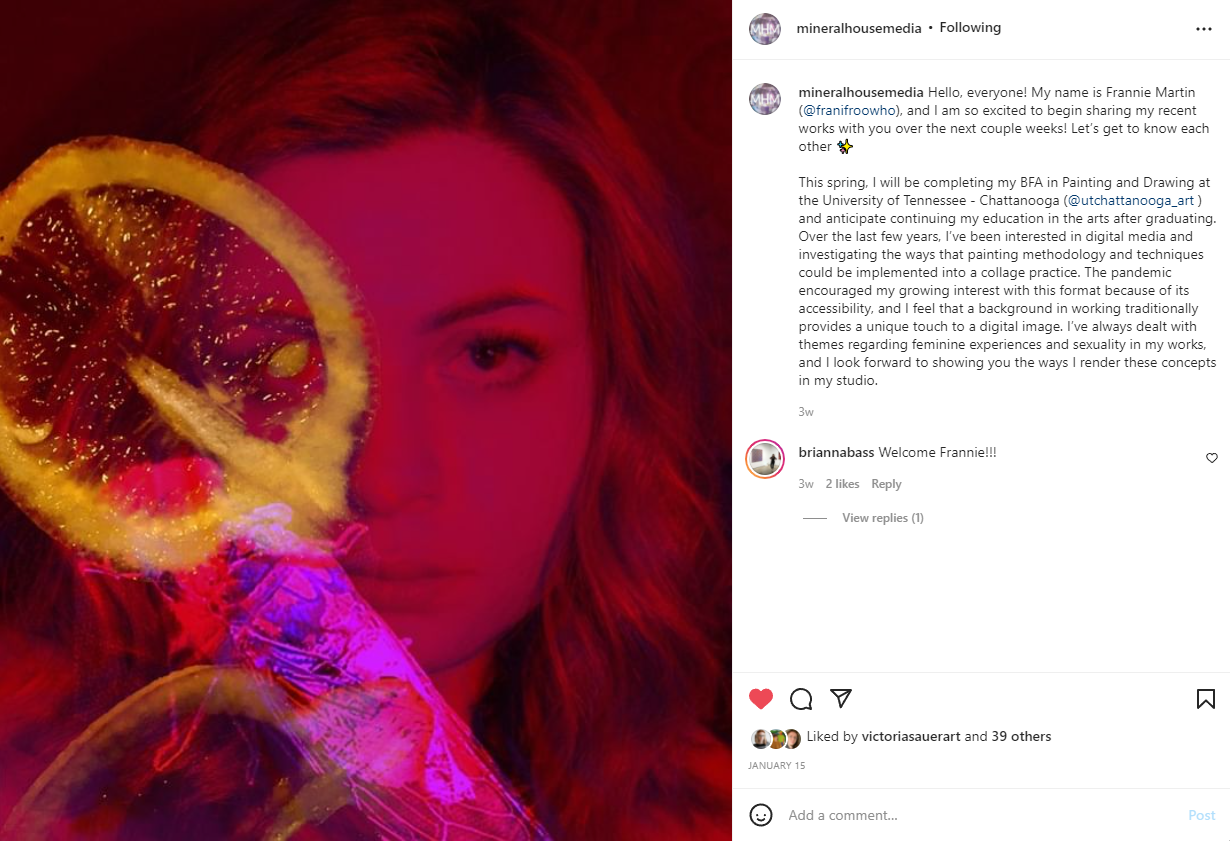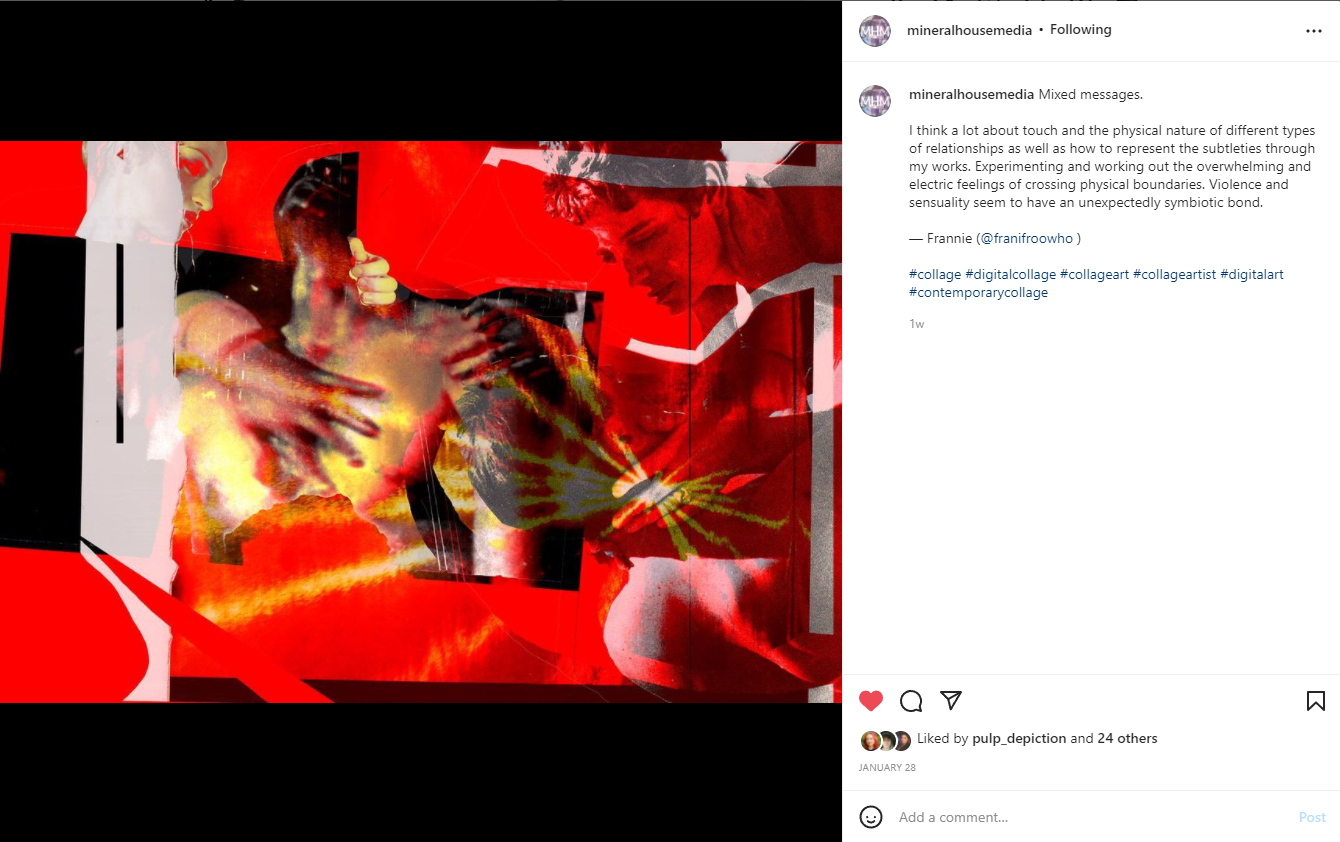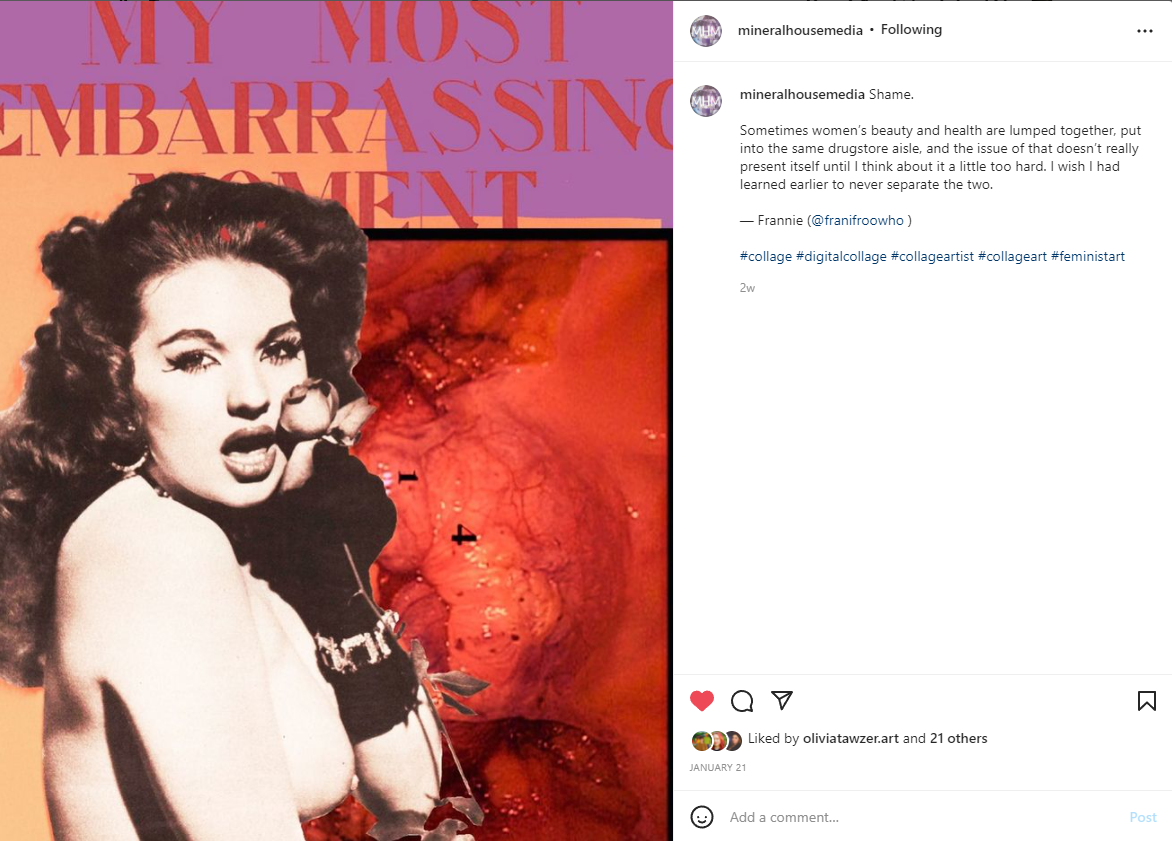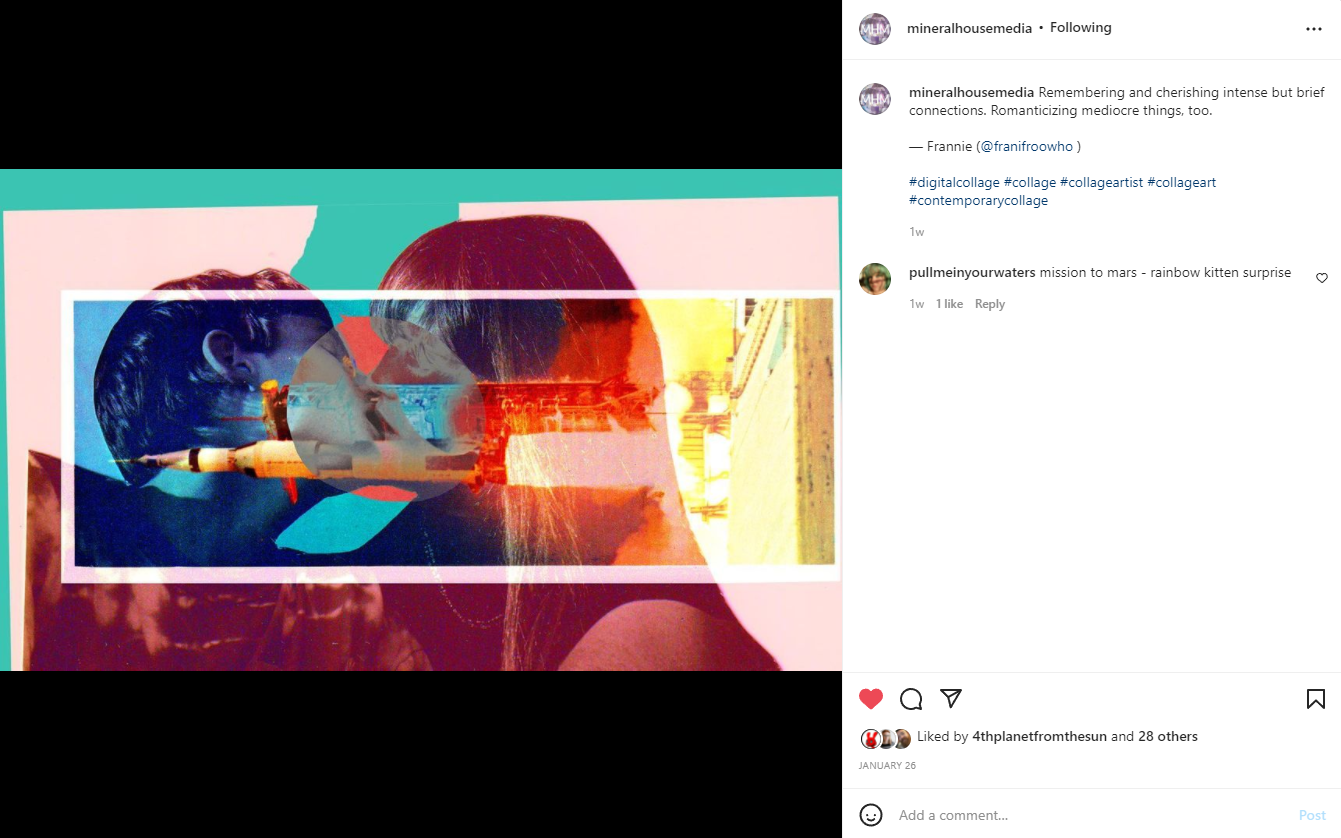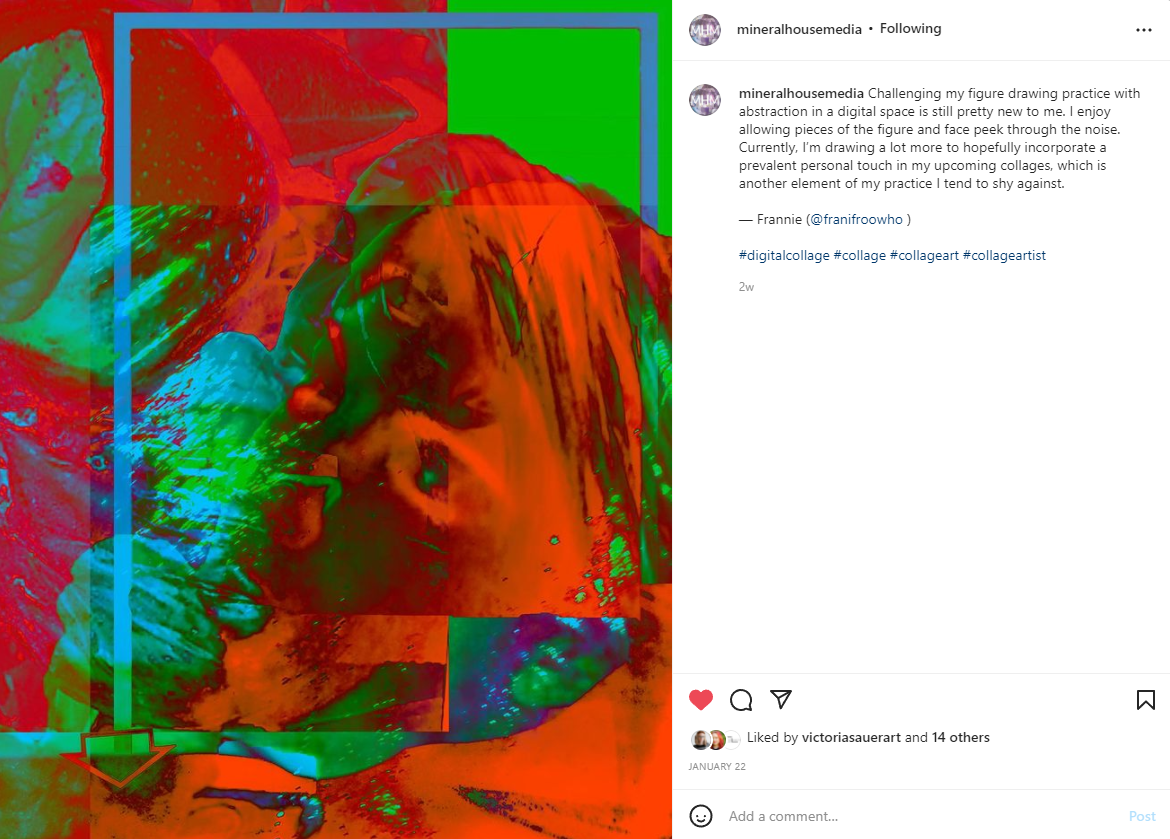Interview with Frannie Martin
Interview with
Frannie Martin
January 2022 Digital Resident
A conversation with Larkin Cook, Olivia Tawzer, and Clay Aldridge of Mineral House Media
In my studio practice, I have explored the limitations and challenges of digital collage while continuing my formal education. With this specific body of work, I have emphasized this idea of the procreative and sexual body, focusing on imagery relating to the visceral, violent existence of human interaction through an exhausted feminine as well as painterly lens. I feel strongly that the act of collage is inherently violent through its subversive abilities, so I chose to manipulate the found imagery to speak in a transformed display in the digital space. I engage with materiality of the original images’ sources and use the existing visual language like I would use ready-made paint on a palette.
-Frannie Martin
MHM: Can you talk about the ways that your background in painting has influenced your collage/digital work?
FM: For me, having a background in painting allows me to view existing images as material matter; I feel that the cutting and pasting associated with collage speaks the same way that pushing pigments across a substrate holds a place in painting. Being a painter definitely has more to do with the process of creating an image/work than solely what we like to traditionally think of as painting.
MHM: Tell us about your use of text throughout your work. How do you decide which pieces need text?
FM: Text is an element of my works that I often struggle with, especially when I debate including it or not. Do I consider legibility? Is the text important to the piece itself? How important is text to the subject? Sometimes, I make it easier for myself when I find a particular text in a magazine and work from there. However, including text can sometimes be exactly what the work needs to feel complete. Most of the time though, I like to approach text abstractly and consider words or letters more akin to signifiers of mass produced media. As my practice continues, I want to try incorporating my own text with more intention.
MHM: Some of your source material seems to be from old advertisements objectifying women’s bodies, but your method of editing is very contemporary. How do you think about recontextualizing potentially problematic imagery?
FM: I really enjoy the act of recontextualizing and appropriating sexist imagery from the past because it gives me—a woman artist—an opportunity to express my own agency and voice in a conversation in which I was never meant to be included. Truthfully, I find a great deal of humor in the act at times because the images’ often hypersexual, overtly misogynistic displays seem so ridiculous to someone in 2022. But even in finding joy in reclaiming the feminine figure, I also use it to cope with the current political associations we have with the contemporary version of the procreative body. Emphasizing the irony in the ways women have been displayed in the media through my art is cathartic as well as exhausting at times because of these reasons.
MHM: You say you collect material that you are immediately drawn to, then by combining images find meaning and context. Can you speak more to this process?
FM: In a way, I like to think that hoarding images is the best approach to this process. While not necessarily the most efficient by any means, I find great success in having a large selection of images to choose from. Being drawn to an image is the only criteria I have for myself when picking up these images because I feel there is merit to assigning personal meanings later in the process. Generally, we like the things we like for some psycho-social reason, so I think trusting that feeling and your creative intuition is important. After collecting the images, I am able to analyze the why and the connections I have to them once they are in my possession. From that point, I can categorize and catalog them and start working.
MHM: It's clear your work is very personal. Many of your collages feel like portraits, even self-portraits. How do you think about identity and the exploration thereof in your work?
FM: I would say it’s nearly impossible for me to steer away the self-portrait when dealing with feminist topics in my work. My identity has always been highly dependent on the outlook of others, and I always find myself caring more about what others may think or feel about me in any given situation. In exploring self-portraiture, I can finally choose to portray myself however I would like. Having been so heavily influenced by the patriarchal lens and being a victim to my own low self-esteem as a result, I find power in appropriating my own image. My identity has always felt isolated to either my character or my body as a woman, so I try to connect these aspects of myself and create an image that is wholly me. I want to treat myself as I would treat the other girls in my work.
MHM: There is an aesthetic to your work that reminds me of glitch art. Do you consider digital glitch/error when doing digital collage?
FM: I have never explicitly attempted to approach my works thinking of the “glitch,” but I can definitely see why this comes to mind. When working digitally and taking advantage of the digital process, there is an almost inevitable aesthetic you are able to embrace. The error or glitch, while not confined to the digital space, can serve as the medium’s signature touch or texture. As a painter, I like to embrace the notion of the artist’s hand, so I will definitely consider this idea in future work.
MHM: What draws you to explore touch and romance? Could you elaborate on your thoughts and feelings about these two and their relationship?
FM: I believe I have always been interested in portraying intimacy in my works, even before exploring digital collage or painting academically. Touch is a concept relatable to us all, and I feel it is something artists with interest in figurative work have explored often through research and practice. The humanness of romance and the interaction with other people is inherently intimate, and I find beauty is portraying those different relationships in many different ways.
MHM: While working, do you ever have a "failed" piece? One that just isnt working for you? What do you do in that situation?
FM: When going into the collage process, I try to keep an open mind and set a goal to at least learn from the experience. However, I have been disappointed by many pieces that never see the light of day; I’m not even open to critique at some points! When this happens though, I will typically start over or scratch several layers or images from a composition. Surprisingly, there have been times where I have taken a work I felt wasn’t working and simply reoriented the canvas, saving the day. The great thing about “failing” in digital collage is being able to save your work for later or delete the image completely.
MHM: Some of your work combines grotesque imagery with beautiful, idealized images. Can you talk about your decision to juxtapose these?
FM: As a figurative artist, I feel that the human body should be appreciated and viewed for more than what we can see in an academic nude, for example. The body is beautiful in its function and variety of forms, but we know that the grotesque, biological existence of the body cannot be ignored. This is especially true when we consider how the woman’s body is often portrayed elegantly, flawlessly in the Western canon and contemporary media. Because of this phenomenon, I sometimes long for a more visceral display to remind the viewer that the gross aspects of life and human image are still there.
MHM: What materials currently influence your practice? (i.e. other artists, books, music, ideas, etc.)
FM: I have quite a few artists that I feel constantly influence my works and my ideas: Käthe Kollwitz, Mary Cassatt, Hannah Höch; more recently, I’ve been inspired by Ray Gun magazine’s late 80s-early 90s artwork and its featured designers. For aesthetic inspiration and guidance on handling physical as well as conceptual materials, I’m looking to artists like David Carson, Karborn, Sally Mann, Jenny Saville, Marlene Dumas, and Lynn Hershman Leeson.
MHM: How do you think about nostalgia and sentimentality in your work?
FM: In my earlier drawing practice, I found solace in portraying warm memories and the people, things I love in my works. With my collages, I think I am drawn to the times I haven’t necessarily experienced and feel a connection to figures of whom I don’t even know the names. Old magazines, posters, textbooks, etc. have had experiences of their own and were created in their own contexts that may or may not be relevant today, but I feel that addressing those times and how they may invisibly influence us today is integral in growing as a visual artist.
